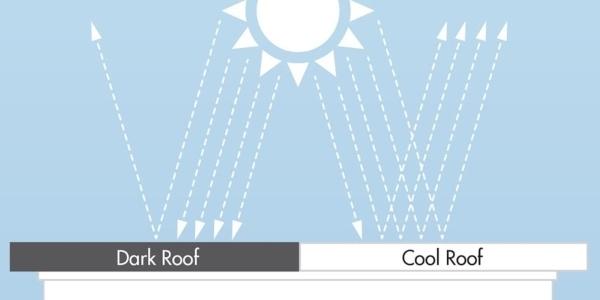Cool Roofs Can Fight Climate Change

By Cass Jacoby.
Did you know the color of your roof can be a climate change solution?
After a summer of record heat waves with the temperature regularly climbing over 90 degrees it is no wonder that more and more building owners and cities are looking into roofing technology that can beat the heat. As the planet warms, cool roofs can help mitigate the heat-island effect.
The heat-island phenomenon is when an urban area tends to be significantly warmer than its surrounding rural areas due to traffic, people, and the miles of glass, asphalt, metal and concrete in the city. City buildings typically absorb heat on their roofs, raising the temperature of the area.
The easiest way to reflect the sun’s rays is to paint a roof a lighter color like white or grey, according to the Guardian. This climate solution is inspired by the Greeks who used this approach in the infrastructure of their buildings to cool their buildings.
For the last 20 years, reflective white coatings have oft been looked at as a way to help combat the heat in the city, as a lighter colored rooftop surface bounces the heat away from buildings rather than absorbing it. These lighter colored roofs have been coined “cool roofs” for the effective way they temper excessive heat from the top down.
That’s right, something as simple as your roof color can be a climate change fighting solution. Energy.gov found that the standard roofs can reach temperatures of 150°F or more in the summer sun, while a cool roof under the same conditions could stay more than 50°F cooler and save energy and money by using less air conditioning. This means that cool roofs can help to reduce greenhouse gas emissions by conserving electricity.
Further, cool roofs cool the world independently of avoided carbon emissions, simply by reflecting the sun’s energy as light back to the atmosphere, thereby mitigating global warming. A Lawrence Berkeley National Laboratory study found that world-wide reflective roofing will produce a global cooling effect equivalent to offsetting 24 gigatons of CO2 over the lifetime of the roofs. This equates to $600 billion in savings from CO2 emissions reduction.
Far more than just an energy issue, Coolroofs.org suggests that there are public health benefits that are associated with the mitigation of the urban heat-island effect and reduction of ambient air temperatures. Rapidly increasing temperatures stress ecosystems, increase the frequency and duration of heat waves and exacerbate air pollution and lead to heat-related and smog-related health issues, including heat stroke and asthma. Cool roofs in turn improve air quality, decreasing the rate of smog formation and combatting heat and smog health issues.
“Rooftops present an important opportunity to both mitigate and adapt to climate change, and to address a range of environmental and social issues,” confirms Emily Nobel Maxwell, New York’s director for the Nature Conservancy in the New York Times.
Ultimately, cool roofs are changing how we think about combatting the effects of climate change. Integrating simple solutions like a new roof color can help to significantly improve the air quality, lower the heat and increase the energy efficiency of a neighborhood and city.
Have a question? AskARoofer.
Find your local roofing contractor in the RoofersCoffeeShop® Contractor Directory.
About Cass
Cass works as a reporter/writer for RoofersCoffeeShop and AskARoofer. When she isn’t writing about roofs, she is writing about movies for her master's degree and dancing with her plants.
Image source: GAF










Comments
Leave a Reply
Have an account? Login to leave a comment!
Sign In